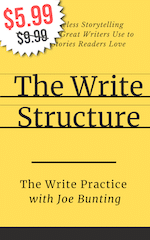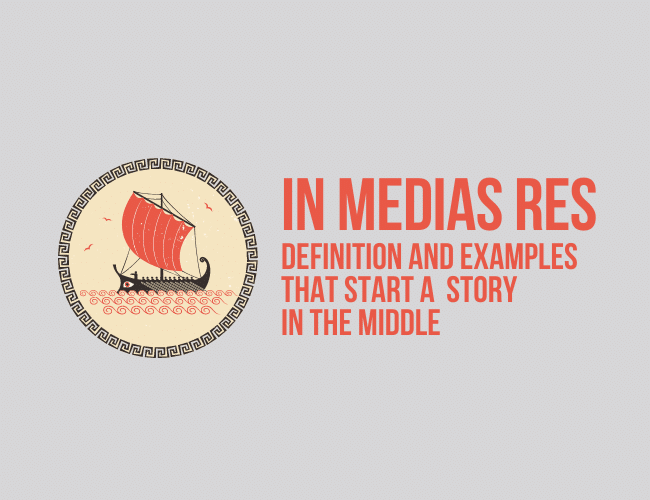The article In Medias Res: Definition and Examples To Start a Story in the Middle appeared first on The Write Practice.
Beginning writers often start stories with a ringing alarm clock, following the protagonist’s daily routine. But what if there’s a better place to begin the story? One that will hook your reader and keep them turning the page? Ancient storytellers understood the power of beginning in medias res. Let’s find out what it is and how you can use it for your story today.
One of the first tough decisions writers make when beginning a story is how to start, or more accurately, where to start the story.
When I say where, I don’t necessarily mean with setting, although that’s part of it. No, I mean in the larger story of this character’s life, where does this particular episode or story begin?
That’s the job of exposition: to set up the character in their world and disrupt them with the inciting incident.
But you don’t want to start on the day they were born or with a ton of unnecessary backstory that will bore the reader. You want to start a scene in the middle of things. You want to hit the ground running with an opening line that puts your main character right into action.
Welcome to the world of in medias res.
Definition of In Medias Res
In medias res is a Latin phrase meaning “in the midst of things.” It’s used as a literary term to explain when a story or scene starts with a character in the middle of the action.
This is more than skipping unnecessary backstory. It is starting somewhere other than the natural starting point in the story.
This could be in the first chapter, we see the characters running from a dragon, or sitting in the principal’s office after a prank gone awry. They could be bailing water out of a flooding dinghy, or wheeling a sick patient into an operating room.
If you’re beginning your story in medias res, the action on the first few pages can come from anywhere along the storyline.
In other words, the first scene could be a slightly later beginning, the climax in the middle of the narrative, or it might pull from the resolution, after all the action has happened, and all the characters are sorting through the events.
Whatever point you choose, you need to know that there are trade-offs. While it creates drama and stakes from the first page, it can also sometimes be confusing for the reader who isn’t acclimated to the world or character yet.
Where Did In Medias Res Come From?
Stories that start in medias res dive into a crucial part of the action in an important chain of events. The events that came before the starting action may be something that the reader learns later in the story, often through flashbacks.
The literary technique originated in two epic narrative poems by the Greek poet Homer: the Iliad and the Odyssey. These poems are some of the foundational work of Greek literature—and prime examples of how to use in medias res in your story.
Here’s how they work:
Iliad
Achilles and Agamemnon fight during the Trojan War. With no exposition, the first line immediately engages the reader with action. The Roman poet Horace first made this observation in his work, Ars poetica.
Sing, Goddess, Achilles’ rage,
Black and murderous, that cost the Greeks
Incalculable pain, pitched countless souls
Of heroes into Hades’ dark,
And left their bodies to rot as feasts
For dogs and birds, as Zeus’ will was done.
Begin with the clash between Agamemnon–
The Greek warlord–and godlike Achilles.
By starting with action, the reader is pulled into the quarrel and war. It also hooks the reader by making them wonder who these characters are and why they are fighting.
Which of the immortals set these two
At each other’s throats?
Odyssey
This poem begins ten years after the Trojan War. The goddess Calypso holds the protagonist, Odysseus, captive. Meanwhile, back in Odysseus’ homeland, a group of suitors preys on Odysseus’ wife, Penelope.
Following this setup, there’s a preview of what will unfold in the rest of the story. This shows us the events that brought the characters to where they are now, which are shared in flashbacks that show us the important details and backstory we need to know.
Today, in medias res can be found in various types of stories, from epic poems to fiction and nonfiction, and even epic films that start the story in the middle of a series. Like, Star Wars.
How to Use In Medias Res in Your Story
What happens after the opening in medias res is up to the writer.
If the opening comes from early enough in the narrative, it’s possible that the writer may continue with the story without bothering to explain why the characters were running from that dragon. It’s also possible that the writer may explain a bit of backstory through the character dialogue after the opening scene.
After the characters escape the dragon, maybe the protagonist pulls a diamond out of their satchel, and the accompanying character makes a comment that they need to find one more diamond before they can assemble the magical staff. This is a quick way to get the reader up to speed, if necessary.
If the in medias res opening takes place closer to the middle or end of the story, it’s also very common for the following scene to take the reader way back to the start of the story. Here the author can explain how the characters ended up in the principal’s office or in the hospital.
The opening scene gives the reader a sense of what’s coming, and then pulls the camera back to show the circumstances that got the characters there.
Memento and In Medias Res
If the writer is feeling really ambitious, the opening in medias res takes place in the middle or end of the story, but then the rest of the story is told in a nonlinear fashion.
For example, the film Memento opens towards the end of the story, but from there it alternates scenes moving chronologically from the start of the story, and scenes taking place right before the last one, until it hits the middle of the story, which actually is the end of the film.
One word of caution: in medias res can be fun, but if you’re introducing too many characters in that opening scene, they can get lost in the action. Make sure to keep a close eye on the key characters introduced, and make sure the reader is able to keep that close eye as well.
Starting Your Story In Medias Res
There are various ways to use in medias res in your story.
As discussed in Homer’s epic poems, both open in medias res and don’t really go into backstory until further on in the narrative.
Just as Homer did, you can skip right to the meat of the story and test out the classic storytelling method.
Who knows, maybe this will be your new favorite literary technique!
How do you feel about stories that begin in the middle of the action? Let us know in the comments.

PRACTICE
Let’s practice in medias res!
Today, spend fifteen minutes writing an opening that starts in medias res. Use one of these prompts for inspiration:
- A house is on fire.
- An older man is proposing to his date.
- A jockey locks his eyes on the finish line of an important horse race.
When you’re done, share your practice in the Pro Practice Workshop here, and leave feedback for a few other writers. Not a member? Join us here.
The article In Medias Res: Definition and Examples To Start a Story in the Middle appeared first on The Write Practice. The Write Practice – The Online Writing Workbook
Go to Source
Author: Liz Bureman
